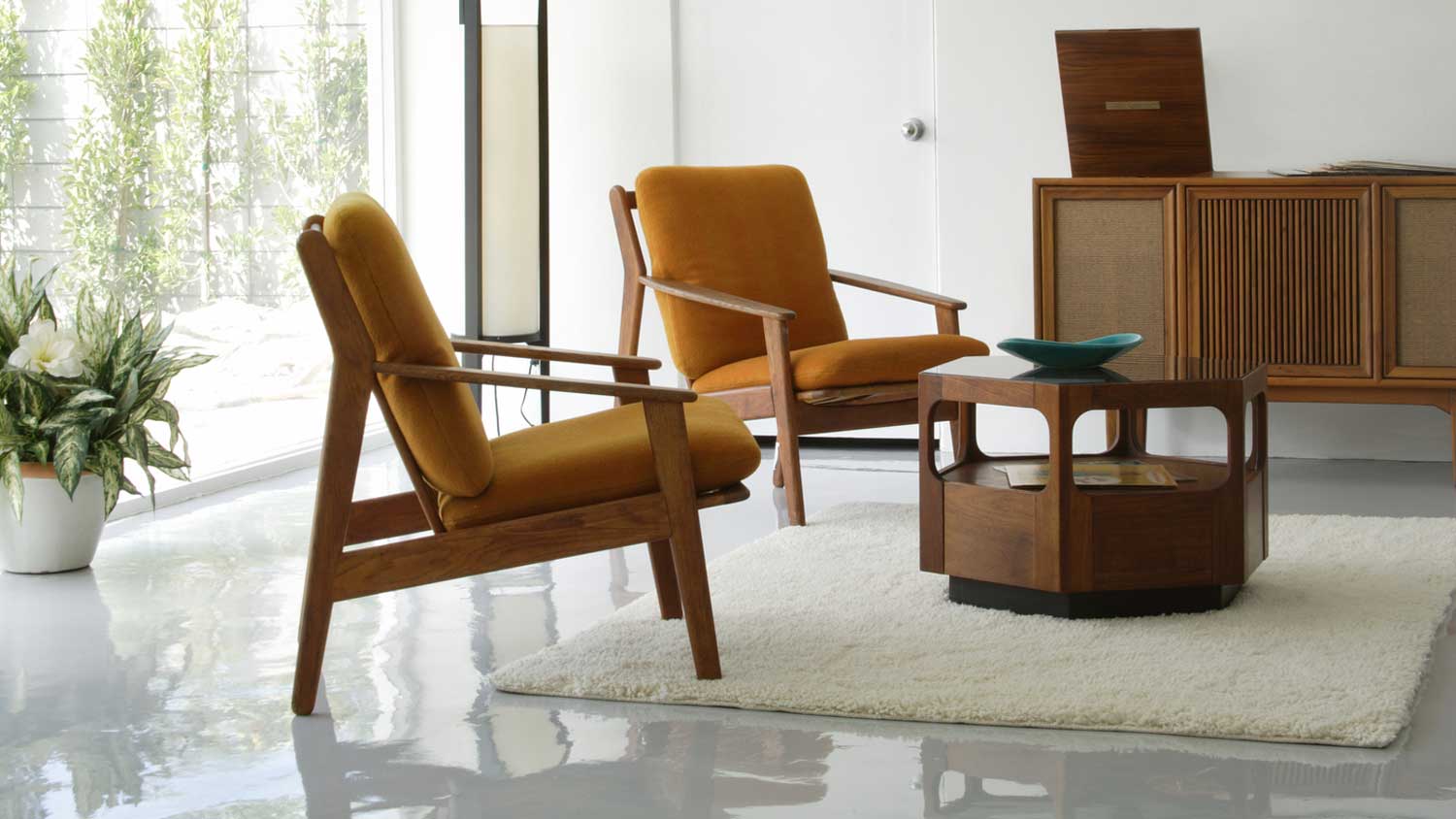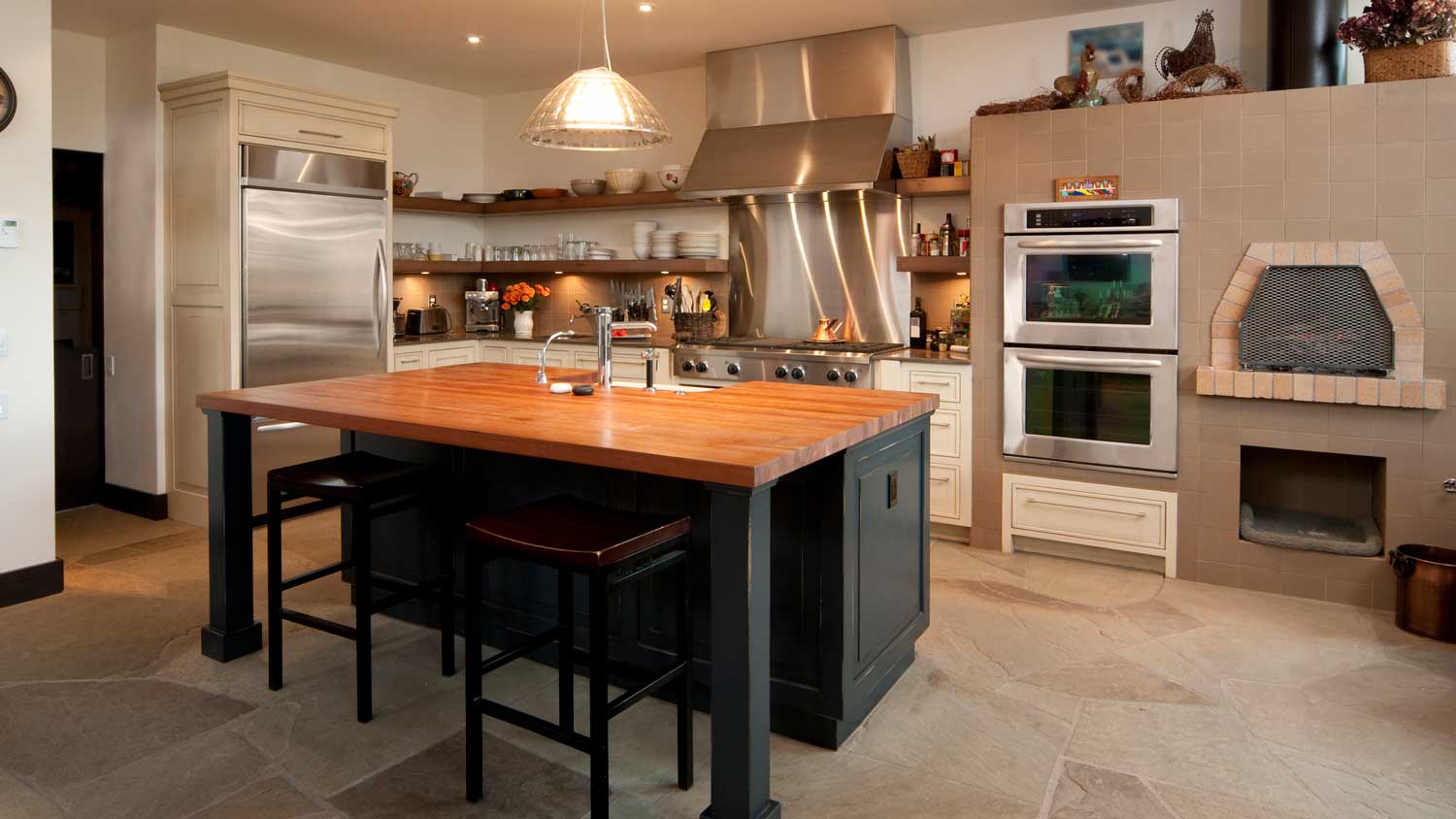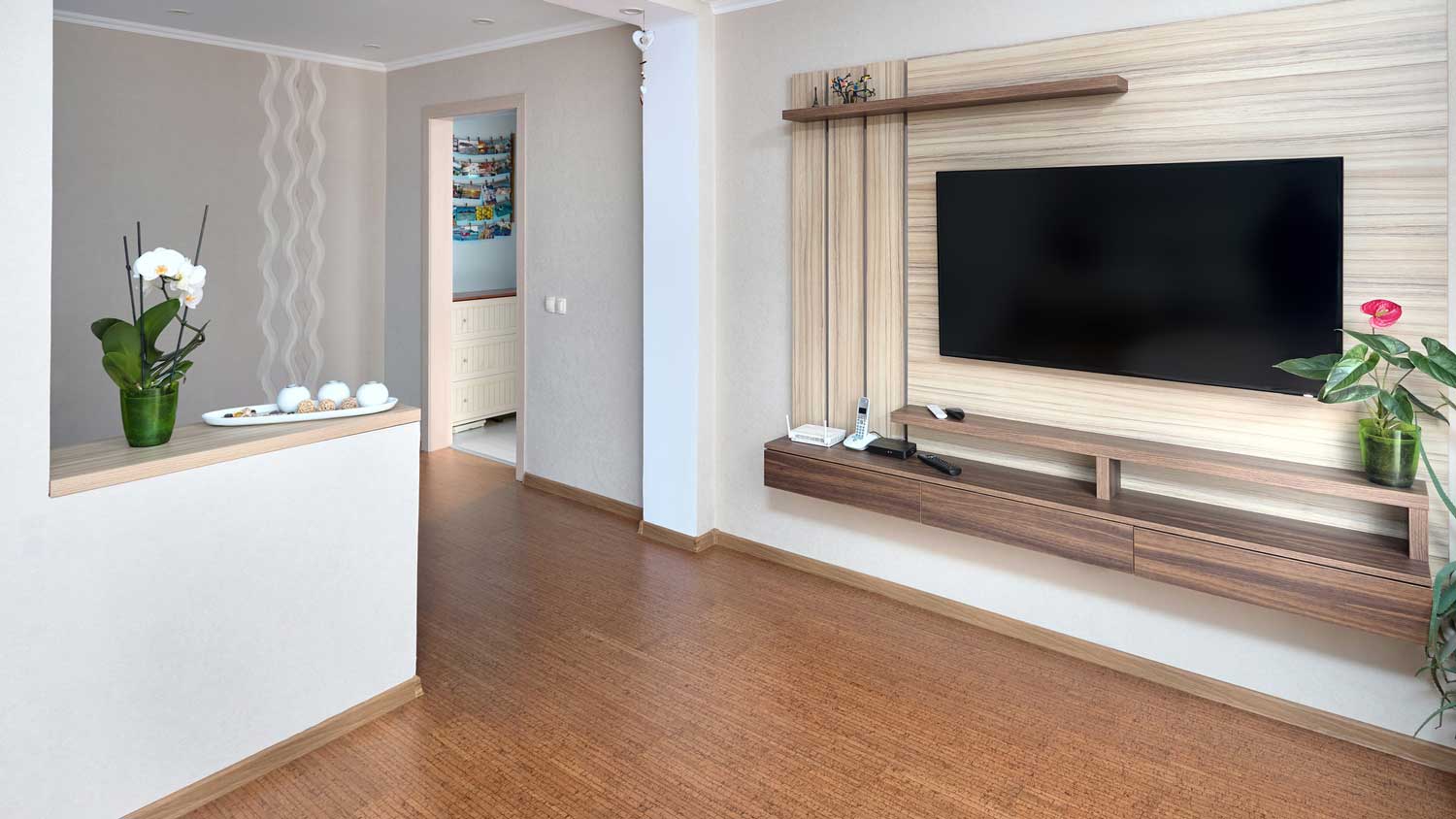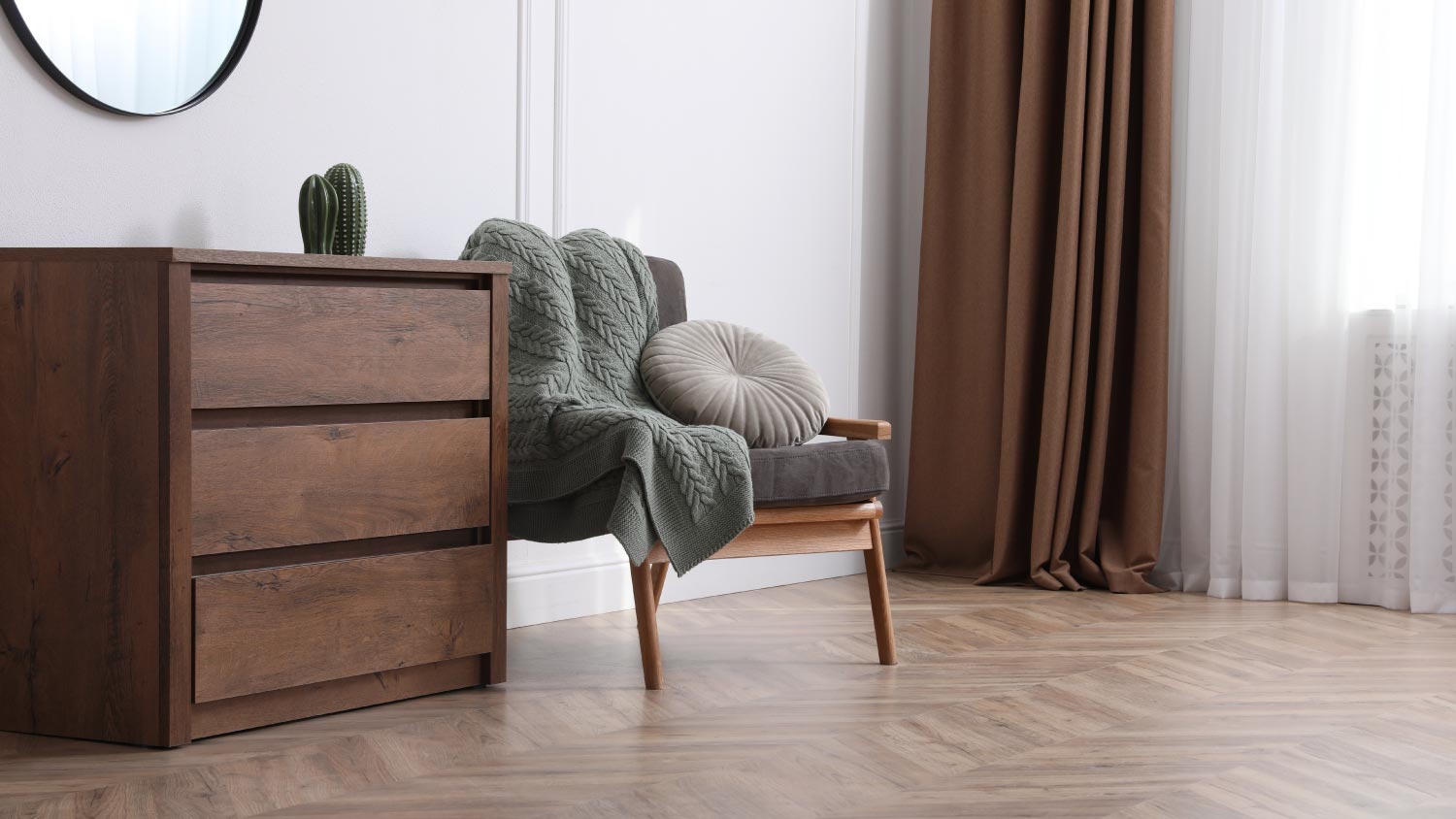
Linoleum is a popular flooring material because it’s one of the most affordable—but linoleum flooring costs vary from project to project. Let’s break it down.
Weigh the pros and cons of each flooring option for your home


Your flooring is kind of important—it literally lays the foundation for everything that happens in your home. With so many types of flooring to choose from, making a decision can literally feel like you’re walking the plank (be it affordable vinyl plank or genuine hardwood). That said, finding the perfect fit is a matter of weighing the pros and cons. Let’s dive in.

If you want durable flooring that will never go out of style, you’ll be hard-pressed to find a better option than hardwood. Not only does it add warmth and character to any space, but this high-end flooring material also adds value to your home.
Hardwood flooring is susceptible to denting, so higher hardness ratings will indicate what to use in very active rooms. Oak, maple, and hickory tend to be on the hardest end of the spectrum. Walnut is a bit softer but has a coveted aesthetic. Keep in mind that hardwood scratches easily, but a good buffing will take care of most minor marks.
Beautiful and timeless style
Many different varieties to choose from
Excellent ROI
Resurfacing every 3–5 years can keep it looking good as new
More expensive than other flooring varieties
Softer woods like pine or maple can get damaged easily
Susceptible to water/moisture damage
Can stain and absorb odors quickly
May develop dents, scrapes, and scratches over time
Hardwood floors cost between $6 and $12 per square foot for materials and professional installation. Rare types of hardwood floors can reach up to $25 per square foot. Later down the line, expect to spend an average of $1,900 on the cost to refinish hardwood floors, staving off the need for a potential replacement if your flooring is seriously worse for the wear.
While you can extend hardwood floors to all rooms and hallways of your home, they hold up best in communal spaces like living rooms and dining rooms. Installing hardwood flooring yourself is not for the new DIYer and is best when performed by an experienced pro.

Engineered hardwood has a veneer of real hardwood as its top layer, so it’s nearly indistinguishable from hardwood flooring. Beneath that veneer are several core layers of high-density fiberboard, plywood, or hardwood. These inner layers provide more stability than solid hardwood floors, while the veneer gives it the same natural beauty.
Imitates the same timeless look of real wood
Far less susceptible to moisture and humidity than hardwood
Multiple layers block moisture and provide extra stability
Usually less expensive than hardwood (though not by much)
Will not warp or bulge with proper installation
More environmentally friendly than traditional hardwood
Just as susceptible to scratches and dents as real hardwood
Refinishing is possible, but only once or twice before the veneer gets too thin
Not moisture-proof and can grow mold or mildew when flooded with water
More expensive than carpeting, tile, and laminate
The cost for engineered wood flooring has a wide range from $2.50 to $10.00 per square foot, depending on its quality. However, some click-in styles are easier to install than hardwood, so you may be able to cut out the price of labor.
Yet again, this type of wood flooring does best in communal areas like living rooms, hallways, and dining rooms. While it's a stronger choice for kitchens and bathrooms, it can still warp over time. Engineered wood is also a top choice for floating floors—floors that sit right on top of the subflooring—making this a contender for DIY installation.

There are different types of tile you can use for flooring, but ceramic and porcelain tend to be the most popular. These flooring materials are allergy-resistant, water-resistant, and easy to clean, making them an ideal choice for kitchens, bathrooms, basements, and utility rooms. High-quality tiles can hold up to heavy foot traffic, but there’s also a range of cost-effective options for smaller budgets.
Along with the benefits, there are some downsides to porcelain or ceramic tile flooring. The installation process is quite laborious since contractors will have to lay tiles individually. Grout can also be difficult to maintain, and tiles can shatter on impact. Luckily, you can replace individual tiles along with the grout.
Tons of beautiful options
Nonporous and waterproof
Easy to clean
Great for use with radiant heating
Can get expensive (comparable to hardwood flooring)
Chips and cracks easily
May be difficult to install
The cost to install tile flooring is typically between $15 and $20 per square foot, but there is a vast range of prices for porcelain and ceramic tiles. You'll find tiles for as little as $0.50 per square foot and all the way up to $40. You can, however, save money by installing the tiles yourself.
The beauty of ceramic and porcelain tiles works best in the prep rooms of our homes such as the kitchens, bathroom, foyer, and hallways. For this reason, you'll rarely find them in living rooms and bedrooms, but it's unheard of in modern homes.
Natural stone floors may be an investment, but it can increase the value of your home and last as long as hardwood flooring. While you'll often find it in foyers, porches, kitchens, and bathrooms, blend the outdoors with the interior by including it throughout your home.

Laminate is often used as an alternative to hardwood, favored for its affordability, durability, and realistic look. The higher the quality, the more realistic the printed design layer, which often mimics natural wood or stone. This flooring material is made from four different layers:
A back layer that protects the plank and balances the floor
A core layer made of a high-density wood chip composite
A design layer made from decorative paper
A wear layer consisting of a clear coating that protects the surface
Despite the benefits, laminate flooring is vulnerable to water damage and difficult to repair. Since it’s relatively easy to install, homeowners typically just replace the damaged planks.
Many stylish options to choose from
More budget-friendly than wood or tile
Doesn’t expand or contract like hardwood
Resists stains and scratches better than wood
Won’t fade in the sunlight
Easy to install
Susceptible to water damage
Planks can develop gaps if temperatures become too low
Can be slippery
Difficult to repair
You'll pay between $1.30 and $6.00 per square foot for the cost of laminate flooring including labor and materials. However, materials alone cost just $0.70 to $2.00 if you opt to install it yourself.
Like hardwood floors, you can extend laminate flooring all the way from the foyer to the bedroom. However, it doesn't do as well in water-prone bathrooms and kitchens.

Vinyl is actually one of the best types of flooring for dogs. This option—which comes in sheets, tiles, or planks—is affordable, comfortable on the feet, easy to install and easy to clean. The main benefit beyond price is that it’s nearly 100% waterproof since it’s primarily made from PVC (along with other compounds).
Overall, vinyl is one of the best flooring materials for households on a budget, and it performs particularly well in rooms exposed to moisture, like bathrooms or kitchens. Though it’s prone to wear and tear over time, you can purchase more durable varieties. Sheet vinyl tends to be the least durable, while LVP (luxury vinyl planks) and LVT (luxury vinyl tiles) are thicker and more durable.
Affordable
Versatile
Waterproof
Long-lasting
Resists scratching
Many beautiful styles to choose from
Low-maintenance
Easy to install
Not damage-proof (e.g. furniture gouges, deep scratches, etc.)
Doesn’t deliver the same ROI as wood
Can get discolored in the sunlight
Can wear over time
Often isn’t recyclable
You can expect to pay $3 to $7 per square foot to install a vinyl floor. The final cost depends on the size of your space and whether you choose sheet vinyl (which typically costs $3 per square foot) or vinyl tiles (which can cost up to $7 per square foot).
If you’re an experienced DIYer, you can save on labor fees by install a vinyl floor yourself.

Linoleum often gets mixed up with vinyl, but there are slight differences. You can recycle linoleum, and it’s more environmentally friendly because it’s made from natural materials like linseed oil, pine rosin, and jute. As a result, it’s not waterproof and does require sealing.
If you plan to install linoleum floors, you can choose from sheets (which you’ll typically glue down) or tiles (which usually lock together). This material can be difficult to install, so you may want to hire a flooring company near you to take on the job.
Affordable
Resists fading
Made of recyclable materials
Excellent heat resistance
Long-lasting
Fewer styles to choose from
Not waterproof
Needs regular sealing to resist moisture
Can get gouged or scratched easily
May get ruined by flooding
Like vinyl, linoleum typically costs $3 to $7 per square foot including installation. Keep in mind that professional installation runs about $36 an hour, so the layout of your room may contribute to the cost.
The mid-century look of linoleum works best in areas like bathrooms, kitchen, mudrooms, and foyers. However, since some linoleum styles mimic stone and hardwood, it can even extend to the living room and dining room. DIY installation can be complex, so we recommend calling a professional.

No other floor is as pleasing for the feet as carpeting, but it gets a bad rap for how difficult it is to clean. Muddy pawprints and spilled drinks can spell disaster, but they don’t have to be a death sentence. Investing in the cost of carpet cleaning on a regular basis can keep it looking fresh. There are numerous other ways to keep your carpet looking new as well.
Many affordable options
Retains warmth
Soft and comfy to walk on
Difficult to clean, especially dust and fur
Absorbs odors
Not allergy-friendly
Luxury styles can get pricey
Including materials and labor, installing carpet costs between $3.50 and $11.00 per square foot. Prices range depending on whether you opt for a low-cost option like polyester or a higher one such as cotton.
Homeowners often opt for wall-to-wall carpeting in bedrooms, especially those for kids and teens. Carpeting installation is also not a recommended DIY job, so be sure to find a local carpet installer to get the job done right.

You may know resin flooring by another name—epoxy floors. Technically, epoxy is a type of two-part resin. Most often, you’ll find this flooring material in garages, basements, and workshops because it’s one of the most durable on the market (particularly if you choose a commercial-grade epoxy).
Resin does have some nuances. Installation is often messy, and it’s risky to install over wooden subfloors because the epoxy could shatter. If you choose a budget-friendly, water-based resin, you will need to recoat your floor every couple of years.
Extremely durable
Customizable
Heat, crack, and stain resistant
Easy to clean
Budget-friendly
Water-based types are less durable
May need to recoat every couple years
Messy installation for DIYers
Not ideal for homes with wooden subfloors
Can be slippery
May require UV coating
For most homeowners, epoxy floors cost between $1,600 and $3,300 on average. In general, expect to spend about $3 to $12 per square foot, with additional costs for anti-slip coatings and UV protection.
It’s best to install this type of flooring over a concrete subfloor since wood subfloors are flexible. Over time, this could cause your epoxy to shatter. You’ll need to roughen up the surface of your concrete (typically via an etching solution) for the epoxy to adhere.

Concrete flooring can be so much more than what you imagine in the run-of-the-mill garage. There are a ton of different concrete floor finishes, only some of which have an industrial aesthetic. In truth, a polished concrete floor can have a luxe look akin to marble (at a fraction of the cost).
Most often, you’ll find concrete floors in garages, basements, or industrial areas, but you can install concrete just about anywhere. This flooring material is so durable that it can survive for decades. That said, concrete floors are heavy. This type of flooring is best for homes with slab foundations or you may need to structurally reinforce your floor before installation.
Highly durable
Long life span
Low maintenance
Budget-friendly
Polished concrete can be slippery
Falling on concrete can cause injury
Cold on feet without radiant floor heating
Porous if not properly sealed
Prone to cracks
May require structural reinforcement
In general, polished concrete floors typically cost $2 to $16 per square foot, but there are a wide range of potential prices. You can expect to spend as much as $30 per square foot to pour a brand-new concrete slab and even more if you need to reinforce your flooring.
Concrete is heavy, so it’s important you get a professional to inspect your flooring and determine whether or not you’ll need structural reinforcement. Overall, it’s best to leave this type of flooring to homes with slab foundations.

If you’re looking for a classic but durable type of flooring that works in all kinds of spaces, try natural stone. Natural stone flooring is suitable for both indoor and outdoor use. Most commonly, you’ll find it in bathrooms, kitchens, and patios, though you can really put it anywhere.
Popular types of natural stone flooring include marble, travertine, limestone, granite, slate, and soapstone. Each has slightly different properties, though stones will have an absorption rating and grade. Less porosity is better for areas exposed to moisture, while lower grades tend to be the highest quality.
High durability
Low maintenance
Indoor or outdoor usage
Sustainability
Options at different price points
High cost
Time-consuming installation
May require sealing
Floor may require structural reinforcement
If you go for natural stone, expect to spend $6 to $20 per square foot on the cost of new flooring. The material itself usually costs $5 to $15 per square foot, but exotic or luxury stones can cost more.
Pick your finish wisely. Polished stones have a luxury appearance that adds elegance to an indoor space, honed stones tend to have a more natural appearance, brushed stones have rustic appeal, and tumbled stones have a worn-in appearance ideal for outdoor areas.

Cork is a natural softwood that’s rising in popularity for its unique look and reasonable price point. This low-maintenance flooring material has a number of benefits. It’s easy on allergy sufferers, helps dampen sound, and has a softer feel beneath the feet. It’s also easy to maintain since scratches tend to blend in with the floor’s natural texture.
Unfortunately, where cork flooring struggles is long-term durability. It is durable, but compared to other flooring materials, it struggles under the pressure of heavy objects. It’s porous, which makes it prone to water damage, and it can discolor in the sunlight.
Hypoallergenic
Reasonable price point
Natural, recyclable material
Dampens sound
Soft
Poor durability under heavy objects like furniture
Expands and contracts with moisture
Requires sealing
Prone to UV discoloration
Prone to pet-related damage
Cork flooring typically costs between $3 and $10.50 per square foot, which is more than vinyl and laminate but similar to bamboo or carpet.
Since cork is porous, you’ll need to seal it so it doesn’t warp with moisture. You may want to install it in areas less prone to moisture and water.
Now that you know some of the most popular types of flooring, how do you choose? You’ll need to think about the way your floor works in your home. Certain materials may excel in one area and fail in another.
Always keep durability in mind—and this includes water resistance. In areas with high levels of moisture, you’ll need a material that doesn’t warp or stain when exposed to water. In high-traffic areas, you’ll need a material that can handle repeated foot traffic and won’t easily scratch or scuff.
Some floors do require more maintenance than others. If you really like the look of a certain material, you may not mind re-sealing or re-finishing your floor every couple of years. In the same breath, you may want a no-fuss floor you can install and easily wipe clean.
Regularly cleaning your flooring can go a long way in not only making it shine but also making it last. Dirt and debris can scratch your floor and create more problems. Clean your floors with the products and equipment recommended by the manufacturer.
Different flooring materials have different price points. Certain stones and hardwoods will cost more than other types of stones and hardwoods. However, budgeting for new flooring isn’t just about up-front costs. If you choose a low-quality type of flooring, frequent repairs will impact your total spend.
You may not mind a hard surface in your garage. In fact, it’s a benefit if it needs to support the weight of your car. But you may want a cozier feeling on the feet in an area like your bedroom or living room.
Alison Kasch contributed to this piece.
From average costs to expert advice, get all the answers you need to get your job done.

Linoleum is a popular flooring material because it’s one of the most affordable—but linoleum flooring costs vary from project to project. Let’s break it down.

Discover stamped concrete wall cost estimates, including average prices, key cost factors, and tips to help you budget your project with confidence.

OSB is a common material used for subflooring, wall sheathing, and roofing. Here’s a breakdown of how much OSB panels will cost for your project based on type and size.

Learn how to fix scratches in bamboo flooring with these simple DIY strategies and what to do to prevent them from returning.

There is more going on with moisture in your concrete than what meets the eye. Get to the bottom of it by testing moisture levels in your concrete floors.

If you have ever wanted to learn how to install transition strips on concrete, this resource will equip you with everything you need to know.